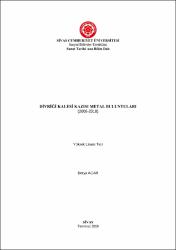| dc.contributor.advisor | Acara Eser, Meryem | |
| dc.contributor.author | Acar, Derya | |
| dc.date.accessioned | 2022-04-28T09:26:18Z | |
| dc.date.available | 2022-04-28T09:26:18Z | |
| dc.date.issued | 2019 | tr |
| dc.date.submitted | 2019-07-04 | |
| dc.identifier.other | xi, 305 | |
| dc.identifier.uri | https://hdl.handle.net/20.500.12418/12596 | |
| dc.description.abstract | Divriği Kalesi’nde, 2006-2018 yılları arasındaki kazılarda bulunan metal
eserlerin incelenmesine yönelik bu çalışmada, çoğu günlük yaşamda kullanılmış ve
çivi, nal gibi yerel atölyelerin ürünü olan buluntuların değerlendirilmesi ve maden
sanatı içerisindeki yerinin saptanması hedeflenmiştir. Her grup önce genel özellikleri
ve işlevleri açısından ayrı başlıklar altında tanıtılmıştır. Kalenin jeolojik ve coğrafi
durumu nedeniyle alanda stratigrafik bir kazı yapmak güç olduğundan, buluntuların
tarihlendirilmesi benzer örnekler ile karşılaştırarak ve Kalenin tarihçesi, Kalede
egemen olan gruplar göz önüne alınarak yapılmıştır. Özellikle, benzerleri
Anadolu’da tespit edilemeyen buluntularla ilgili soru işaretlerinin çözülmesi
amaçlanmıştır. Günlük sosyal yaşamı dolduran birçok metal eserin yaşantımızda ne
kadar önemli oldukları, işlevleri değişmeden günümüze ulaşmış örneklerle ortaya
çıkmaktadır.
Buluntuların niteliği ve tarihlendirmeleriyle ilgili yapılan genel
değerlendirmede çoğunluğu bakır alaşım malzemeden yapıldıkları, Kalede yapılan
kazı çalışmalarında tüm alanlardan metal objelerin geldiği ve Geç Roma-Erken
Bizans döneminden itibaren Beylikler, Selçuklu ve Osmanlı dönemlerine ait kişisel
kullanıma ve günlük yaşama ait eşyaların olduğu görülmektedir. | tr |
| dc.description.abstract | In this study that has been intended examination of metal objects, which were
found in excavations carrying out in Divrigi Castle between 2006 and 2018, it has
been targeted firstly the evaluation of findings in which most of them were used in
daily life and which they were products of local workshops like nail and horseshoe
and the determination of place of these findings in metal works secondly. Each group
was firstly introduced under separate headings in terms of their general
characteristics and functions. Since it is difficult to carry out a stratigraphic
excavation in the area due to the geological and geographical situation of the castle,
the dating of the findings was made by comparing with similar examples while
history of the castle was generated by taking into consideration of the dominant
groups in the castle. In particular, it was aimed to solve the question marks about the
findings whose similarities could not be detected in Anatolia. By means of examples,
it emerges the importance of many metal objects, which occupy daily social life, in
our life and the fact that these metal objects have reached today with their unchanged
functions.
In the general evaluation that has been made about the characteristics and the
dating of the findings, it has been detected that most of the findings were made from
copper alloy material. In the excavation works that were carried out in the castle, it
was observed that metal objects were obtained from all part of the excavation area.
The findings, which were parts of mostly individual usage and daily life pertain to
the period from Late-Roman and Early-Byzantine to periods of Beyliks, Seljuk and
Ottoman. | tr |
| dc.language.iso | tur | tr |
| dc.publisher | Sivas Cumhuriyet Üniversitesi-Sosyal Bilimler Enstitüsü | tr |
| dc.rights | info:eu-repo/semantics/openAccess | tr |
| dc.subject | Divriği Kalesi | tr |
| dc.subject | Mengücekliler | tr |
| dc.subject | Metal | tr |
| dc.subject | Bizans | tr |
| dc.subject | Selçuklu | tr |
| dc.subject | Osmanlı | tr |
| dc.title | Divriği Kalesi Kazısı Metal Buluntuları (2006-2018) | tr |
| dc.type | masterThesis | tr |
| dc.contributor.department | Sosyal Bilimler Enstitüsü | tr |
| dc.relation.publicationcategory | Tez | tr |















